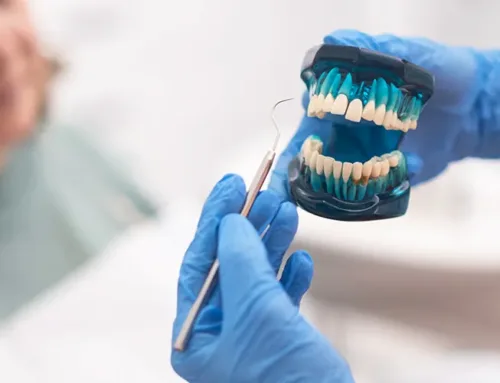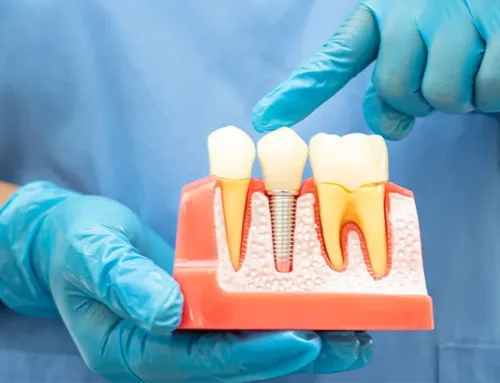Crowns vs. Implants: Two Dental Restoration Procedures
November 30, 2022
When it comes to tooth loss, a decaying tooth no longer serves its purpose, and a missing tooth leaves a wide open gap in your smile. To restore your smile’s function and appearance, there are two recommended dental restoration options; dental crowns vs. implants. While both of these are effective options for solving tooth loss, they address different problems and have key differences to consider beyond personal preference. Let’s begin by outlining what these procedures are, how they’re different, and then we’ll cover how they compare in terms of speed, recovery time, cost, and value.

What They Are
A dental crown is a “cap” that is placed over an existing tooth to restore its function and appearance. Crowns are often used to protect a tooth that has had a root canal, to support a tooth with a large filling, or to cover a misshapen or discolored tooth. Crowns are made from a wide range of materials including ceramic, porcelain, and metals.
Dental implants are artificial replacement teeth that are surgically implanted into your jawbone to fill the gaps of missing teeth. Unlike crowns, which are placed over existing teeth, implants are a stand-alone tooth replacement option that provides a stable foundation for your new tooth. Implants use a titanium post to replace the root of your natural tooth, and a crown sits atop the post, while a metal knob (abutment) connects the two.
How They Differ
It can be easy to get the two mixed up as the dental implant incorporates the use of a crown, making it seem like these two procedures are interchangeable. While the crown portion of the dental implant is very similar to that of a regular crown, the difference is in the placement of the crown. A singular crown is placed on top of an original, natural, and existing tooth, while an implant with a crown component is placed on top of a metal post that is surgically implanted into your jawbone.
The Problems Dental Crowns vs. Implants Solve: What You Need to Know
The best way to determine if you need crowns vs. implants is to take a look at what type of restoration problem you’re trying to solve.
- Dental Crowns.
- Dental crowns are great for when there is a large amount of decay present in a tooth, resulting in a filling that takes up the majority of the tooth. Permitting that the structural integrity (outer walls) of the tooth is solid, it can be filled and topped with a crown to seal it from further harm.
- Dental crowns are often used after a root canal treatment. When bacteria infects the pulp of your tooth, it causes an infection at the bottom of your tooth’s roots. When this happens, a root canal is needed to clear out the infected tissue, blood vessels, and nerves. Once these are removed by drilling down into the tooth, the tooth is filled in and sealed with a crown.
- If you have a severely chipped or cracked tooth, these can be filled in, and a crown can be placed on top to prevent it from re-chipping or re-cracking.
- Misshapen or discolored teeth can also be addressed with dental crowns, as the porcelain or ceramic material used can be matched to the color of your existing teeth.
- Dental Implants. Unlike dental crowns that can provide a solution for several problems, dental implants are ideal for only filling in the gaps of one or more missing teeth. Unlike their counterparts in dentures and bridges, dental implants don’t rely on suction, adhesives, or the support from surrounding teeth to stay in place. They work as a realistic, natural-looking tooth replacement option for individuals that no longer have their original teeth.
Comparing Crowns vs. Implants In Speed, Recovery Time, Cost, and Value
Now that we know what crowns vs. implants are, as well as the issues that each one solves, let’s compare them side-by-side in the categories that matter most: speed, recovery time, cost, and value.
Appointment Speed & Recovery Tim
- Crowns: The dental crown process requires two appointments. The first is to assess the tooth, take x-rays and impressions, and prepare the tooth by removing any decay and shaping it. A temporary crown is then placed on the tooth while the permanent crown is being made in the lab. The second appointment is to check the fit of the crown and to make any necessary adjustments before bonding it to the tooth. The recovery time is relatively short as there’s no surgery involved. You might experience some sensitivity in your tooth for a few days after the procedure as your tooth adjusts to the new crown.
- Dental implants: These take quite a bit longer than dental crowns as there’s a lot of healing time involved. The process for dental implants is usually done in three appointments that span upwards of a few months to a year. If you’ve been assessed and approved for a dental implant, the first step involves placing the surgical post into your jawbone. From here, you’ll need downtime to allow the post to fuse, and the area to heal.
In the second appointment, the healing process will be checked and an abutment (connector piece) will be placed on top of the implant post. The third and final appointment is to take an impression of the abutment, which will be used to make your permanent dental crown.
In terms of recovery time, it can take weeks or even months for your implant post to fuse with your jawbone before you can get your permanent dental crown. After receiving the permanent dental crown, it’s not uncommon to experience some sensitivity and pain as your implant post adjusts.
Costs & Value Received
- Crowns: The cost of your crowns is dependent on the material used, the size of the crown, the location, and whether you have dental insurance. For example, a crown made from gold will be more expensive than one made from stainless steel, porcelain, ceramic, or resin. The cost here is anywhere between $800-2,500/crown. Dental crowns are a great investment as they can last anywhere from five to fifteen years with proper care.
- Dental Implants: The cost of dental implants is more expensive than that of crowns, as you’re paying for the implant post, the abutment, and the crown. The range here is anywhere between $2,500-5000/implant. Dental implants offer excellent value, as they are made to last a lifetime, which is upwards of 25 years with proper care.
So, Which Is Better: Crowns vs. Implants?
While crowns vs. implants are both effective treatments for restoring your smile, the answer on which is better is dependent on your unique needs, budget, insurance, and oral health. If you have your original teeth, dental crowns have a quicker recovery time and don’t require oral surgery, but if you’re missing one or more teeth, dental implants are a long-term investment that can last you a lifetime. If you’re considering either one of these procedures and have questions, be sure to request an appointment with us to see which option is best for you.








